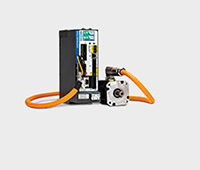Edited by, Barb Schmitz
Nearly every automobile on the road today contains Bosch parts. From a car’s power train to its fuel system, brakes and chassis controls, Bosch components drive the global automotive industry. In addition to being the world’s largest automotive components manufacturer, the Bosch Group produces technologies and consumer goods for applications as varied as packaging, production, and security solutions; home appliances, power tools, and healthcare products; and solar energy, thermotechnology, and turbine systems.
With over 300,000 employees, Bosch takes a thorough approach to identifying design and engineering tools that can help increase productivity. In 1999, Bosch decided to replace the company’s 2D CAD tools with 3D CAD applications, and began a series of pilot programs to test-drive various 3D systems at several different businesses throughout the Bosch organization.

Searching for a 3D CAD system that works with all types of 3D CAD data
According to Janine Essex, Bosch global product manager, the Manufacturing and Support Engineering departments became important contributors to Bosch’s 3D assessment of the various systems. “I went to my director of engineering and said, ‘You really need to look at a 3D CAD application that can work with all the other types of 3D CAD data,’” Essex recalls.
Within the Manufacturing and Support Engineering departments is a Tooling, Engineering, and Facilities (TEF) group. TEF’s work encompasses the development of tooling, fixtures, production machinery and test machines, all of which interface with Bosch product designs. “We needed to pilot a 3D CAD system that could efficiently handle a variety of data formats in order to reach our ultimate goal of streamlining manufacturing,” says Essex.
Bosch launched a pilot program to evaluate the SolidWorks 3D design system with 11 users at the company’s manufacturing facility in Charleston, South Carolina. “We selected SolidWorks because it interacted well with other CAD systems and provided an easy path from 2D to 3D,” Essex explains. “The SolidWorks pilot was so successful that we decided to standardize on SolidWorks for manufacturing, make it available to all CAD users, and support it across Bosch.”

By 2004, there were 300 SolidWorks users at Bosch. Currently there are more than 3,000 across the company, and Bosch has added all SolidWorks design, simulation, and product data management applications to its solution set. “A grassroots movement in support of SolidWorks has taken place within Bosch,” Essex explains. “In addition to Manufacturing and Engineering Support, the Packaging and Security Systems divisions have standardized on SolidWorks for product and large packaging machine design.”
SolidWorks standardization leads to substantial productivity gains
Since standardizing on SolidWorks software for manufacturing and machine design, Bosch has realized substantial productivity improvements. For example, the company has reduced the time it takes to change out fixtures on its manufacturing lines by at least 20 percent. “With SolidWorks, we can very quickly revamp fixturing and make changes to the manufacturing line,” Essex says.
Another tool used internally at Bosch that benefitted from the company standardizing on SolidWorks was CircuitWorks, which is software that enables users to share, compare, update and track electrical design data so users can more quickly resolve electrical-mechanical integration problems.
Using the SolidWorks Application Programming Interface (API), Programmer/Network Analyst Chris Larabell was able to enable the CircuitWorks tool to accept configuration data output by the Zuken ECAD application to automate the creation of mechanical models with multiple configurations directly from the electronic design data. “The CircuitWorks/Zuken integration resulted in a 500 percent savings in time,” Essex says. “That capability resulted in a significant jump in the user base because the amount of time saved is just incredible.”
SolidWorks improves Bosch’s compliance with internal standards
A growing number of Bosch professionals rely on SolidWorks CAD and simulation tools to create and analyze models for products, tooling and machinery, and use the SolidWorks Enterprise PDM system to manage design data. Bosch has a stringent set of standards and procedures—known as “Bosch Norms.”
The SolidWorks API provides Bosch with the flexibility to adapt SolidWorks tools to meet these standards. “We utilize SolidWorks Enterprise PDM, and have created methods that allow us to move drawings directly into SAP, our enterprise resource planning (ERP) system,” Essex says. “We have many automated processes that help our engineers use various SolidWorks applications while adhering to Bosch Norms.”
Open API fuels integration
Not only has SolidWorks worked well with various forms of CAD data, but also in addition the software’s open API gives Bosch the tools it needs to create automated applications that further streamline processes.
“Bosch Norms are the backbone of engineering,” Essex says. “With the open SolidWorks API, we can efficiently implement Bosch Norms into our SolidWorks development applications. There are just so many tools inside SolidWorks that once people start working with SolidWorks and discover the available tools and how easy it is to use them, our number of users just continues to grow.”
SolidWorks
www.solidworks.com
Filed Under: Appliance engineering + home automation, Automotive, ENGINEERING SOFTWARE, MOTION CONTROL, MORE INDUSTRIES





Tell Us What You Think!